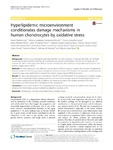Mostrar o rexistro simple do ítem
Hyperlipidemic microenvironment conditionates damage mechanisms in human chondrocytes by oxidative stress
| dc.contributor.author | Medina-Luna, Daniel | |
| dc.contributor.author | Santamaría-Olmedo, Mónica Guadalupe | |
| dc.contributor.author | Zamudio-Cuevas, Yessica | |
| dc.contributor.author | Martínez-Flores, Karina | |
| dc.contributor.author | Fernández-Torres, Javier | |
| dc.contributor.author | Martínez-Nava, Gabriela Angélica | |
| dc.contributor.author | Clavijo-Cornejo, Denise | |
| dc.contributor.author | Hernández-Díaz, Cristina | |
| dc.contributor.author | Olivos-Meza, Anell | |
| dc.contributor.author | Gómez-Quiroz, Luis Enrique | |
| dc.contributor.author | Gutiérrez-Ruiz, María Concepción | |
| dc.contributor.author | Pineda, Carlos | |
| dc.contributor.author | Blanco García, Francisco J | |
| dc.contributor.author | Reginato, Anthony M. | |
| dc.contributor.author | López-Reyes, Alberto | |
| dc.date.accessioned | 2020-03-23T10:39:57Z | |
| dc.date.available | 2020-03-23T10:39:57Z | |
| dc.date.issued | 2017-06-12 | |
| dc.identifier.citation | Medina-Luna D, Santamaría-Olmedo MG, Zamudio-Cuevas Y, Martínez-Flores K, Fernández-Torres J, Martínez-Nava GA, et al. Hyperlipidemic microenvironment conditionates damage mechanisms in human chondrocytes by oxidative stress. Lipids Health Dis. 2017;16(1): 114 | es_ES |
| dc.identifier.issn | 1476-511X | |
| dc.identifier.uri | http://hdl.handle.net/2183/25208 | |
| dc.description.abstract | [Abstract] Background, Currently, two pathogenic pathways describe the role of obesity in osteoarthritis (OA); one through biomechanical stress, and the other by the contribution of systemic inflammation. The aim of this study was to evaluate the effect of free fatty acids (FFA) in human chondrocytes (HC) expression of proinflammatory factors and reactive oxygen species (ROS). Methods. HC were exposed to two different concentrations of FFA in order to evaluate the secretion of adipokines through cytokines immunoassays panel, quantify the protein secretion of FFA-treated chondrocytes, and fluorescent cytometry assays were performed to evaluate the reactive oxygen species (ROS) production. Results. HC injury was observed at 48 h of treatment with FFA. In the FFA-treated HC the production of reactive oxygen species such as superoxide radical, hydrogen peroxide, and the reactive nitrogen species increased significantly in a at the two-dose tested (250 and 500 μM). In addition, we found an increase in the cytokine secretion of IL-6 and chemokine IL-8 in FFA-treated HC in comparison to the untreated HC. Conclusion. In our in vitro model of HC, a hyperlipidemia microenvironment induces an oxidative stress state that enhances the inflammatory process mediated by adipokines secretion in HC. | es_ES |
| dc.language.iso | eng | es_ES |
| dc.publisher | BMC | es_ES |
| dc.relation.uri | https://doi.org/10.1186/s12944-017-0510-x | es_ES |
| dc.rights | Atribución 3.0 España | es_ES |
| dc.rights.uri | http://creativecommons.org/licenses/by/3.0/es/ | * |
| dc.subject | Chondrocytes | es_ES |
| dc.subject | Free fatty acids | es_ES |
| dc.subject | Inflammation | es_ES |
| dc.subject | Oxidative stress | es_ES |
| dc.title | Hyperlipidemic microenvironment conditionates damage mechanisms in human chondrocytes by oxidative stress | es_ES |
| dc.type | info:eu-repo/semantics/article | es_ES |
| dc.rights.access | info:eu-repo/semantics/openAccess | es_ES |
| UDC.journalTitle | Lipids in Health and Disease | es_ES |
| UDC.volume | 16 | es_ES |
| UDC.issue | 1 | es_ES |
| UDC.startPage | 114 | es_ES |
Ficheiros no ítem
Este ítem aparece na(s) seguinte(s) colección(s)
-
INIBIC- REUMA - Artigos [184]






